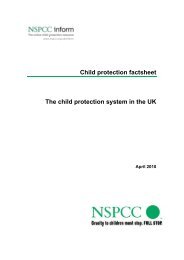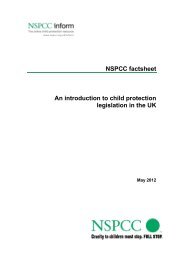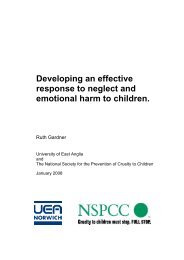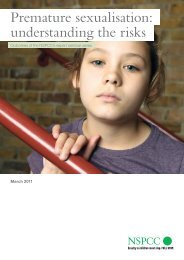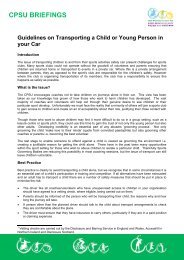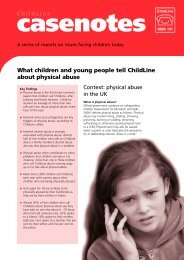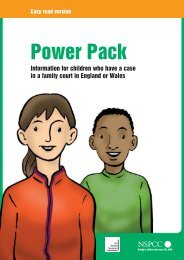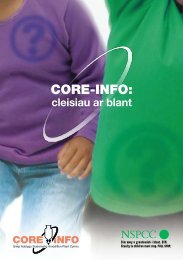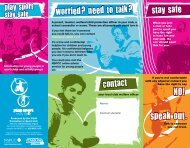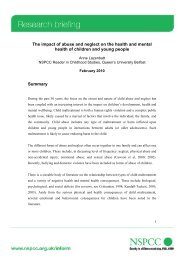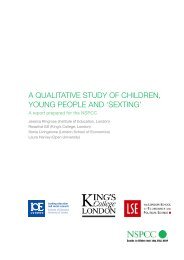Neglect and serious case reviews (PDF, 735KB) - nspcc
Neglect and serious case reviews (PDF, 735KB) - nspcc
Neglect and serious case reviews (PDF, 735KB) - nspcc
Create successful ePaper yourself
Turn your PDF publications into a flip-book with our unique Google optimized e-Paper software.
<strong>Neglect</strong> <strong>and</strong> Serious Case Reviews<br />
70<br />
because they are older <strong>and</strong> have survived into their teens (Stein et al 2009, Rees et<br />
al 2011, Wade et al 2011, Br<strong>and</strong>on <strong>and</strong> Thoburn 2008). Rees <strong>and</strong> colleagues’ recent<br />
work has also given us powerful evidence of the types of neglect that contribute to<br />
young people’s long-term social, emotional <strong>and</strong> psychological damage. There is some<br />
evidence that young people who have lived with maltreatment are more likely to suffer<br />
from physical illness <strong>and</strong> to die early, including by suicide (Meadows et al 2011).<br />
The analysis presented in Chapter 2 showed that neglect featured more prominently for<br />
11–15 year olds than for any other age group (see Table 2.12). When older young people<br />
are the subject of a <strong>serious</strong> <strong>case</strong> review because they have taken their own lives, neglect<br />
<strong>and</strong> rejection feature prominently in their history. A history of neglect <strong>and</strong> the thread of<br />
neglect run through almost all of the <strong>case</strong>s of young suicide in <strong>serious</strong> <strong>case</strong> <strong>reviews</strong>.<br />
There is increasing awareness of the problem of suicide among young people. Establishing<br />
the numbers of young people who die in this way is difficult however since coroners<br />
are reluctant to give a verdict of suicide without corroborating evidence like a suicide<br />
note. A recent statistical release from the Department for Education (DfE 2012) presents<br />
an analysis of the 4,012 childhood deaths reviewed by child death overview panels<br />
between April 2011 <strong>and</strong> March 2012 <strong>and</strong> the extent to which these deaths have factors<br />
which are ‘modifiable’ <strong>and</strong> hence more amenable to prevention. Modifiable factors<br />
were identified in a higher proportion of deaths of older children (nearly a third of all<br />
deaths in children aged 15–17 years having modifiable factors) compared to younger<br />
children (18 per cent of deaths in children ages under one year). The deaths from suicide<br />
were found to have modifiable factors in 41 per cent of <strong>case</strong>s, particularly in relation to<br />
young people’s risk taking behaviour. This underlines the interest in suicide prevention<br />
strategies.<br />
For many young people at the centre of a review the impact of neglect was compounded<br />
by experiencing the whole gamut of maltreatment types at various times through their<br />
life. A number of those who had long histories of agency involvement, were identified in<br />
the 2003–2005 biennial report as ‘hard to help’, <strong>and</strong> consequently found themselves to<br />
be neglected by agencies (Br<strong>and</strong>on et al 2008). The <strong>case</strong> vignette below is a composite<br />
of seven <strong>case</strong>s <strong>and</strong> exemplifies a profile of young people in <strong>serious</strong> <strong>case</strong> <strong>reviews</strong> who<br />
took their own life.<br />
compoSite vigNette – frazer aged 15, Suicide aNd loNg-term<br />
<strong>Neglect</strong><br />
Key features of the <strong>case</strong>:<br />
• Long-term neglect.<br />
• Serious abuse <strong>and</strong> rejection.<br />
• Hard to help young person.<br />
• Suicide.




